| |
Yesterday, we went to Battari-mura, where we observed villagers making tofu the all-natural, old-school way. Tofu-making has a lot in common with cheesemaking, what with all the boiling, pressing, straining, and coagulating of curds. It's hot work, but the end product is well worth it. At Battari-mura, step one of the process involved grinding cooked soybeans with a hand-crank-operated stone mill, complete with straw-and-bucket drip system  After the beans are ground, the resulting mash is boiled for a time, then scooped into a machine where it is pressed in a hand-crank-operated machine (what else?) to extract the soy milk. 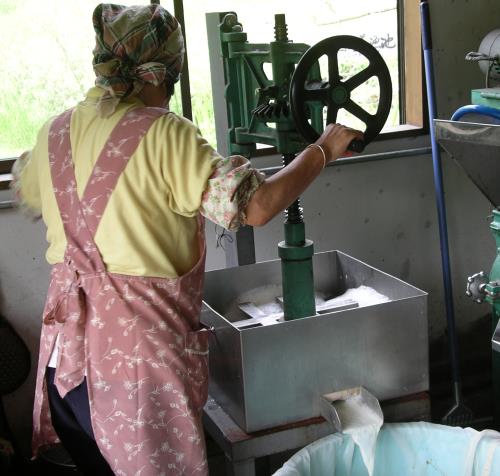 Salts or acids are added to the milk to cause the proteins to coagulate (or, as the maker said, "form a katamari"). It takes a little while for coagulation to occur, but once it does, it happens quickly.  There's more processing involved to get blocks of tofu, but since we were there in part to eat tofu, the woman making it simply scooped the curds out of the bucket and drained them before serving them to us. 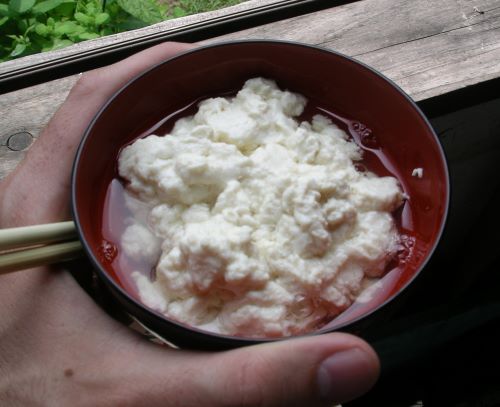 Mmm . . . fresh, delicious tofu.
[ 1 comment ] permalink
There's a little puffery involved in any kind of advertising, but I wonder if Suntory hasn't gone just a leetle bit over the line here:  The Miracle is more delicious than the King, and both are far superior to their compatriot, the less extravagantly named " Sweet Lemon." Maybe Suntory is on to something, although I haven't developed superpowers or anything after drinking the Miracle.
The best thing about summer in Japan: Yamagata cherries. 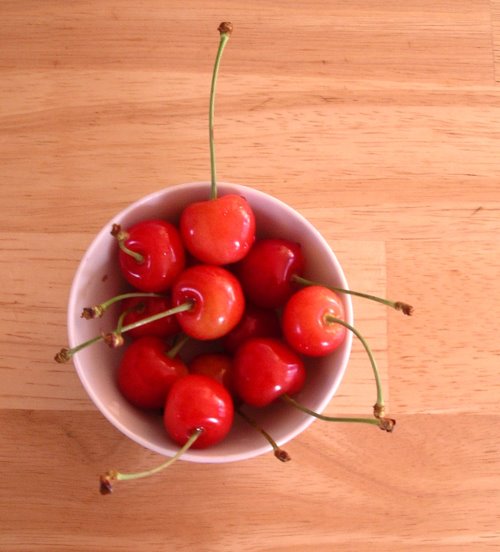 Yamagata Prefecture is famous for its cherries, which are very sweet and beautiful. They can be very expensive ¡½ the posh department store sells large boxes of them, carefully stemmed and arranged into rows, for around 3,000 yen or USD $30. These are not so precious, but man, are they delicious.
Or, "Where It All Began." 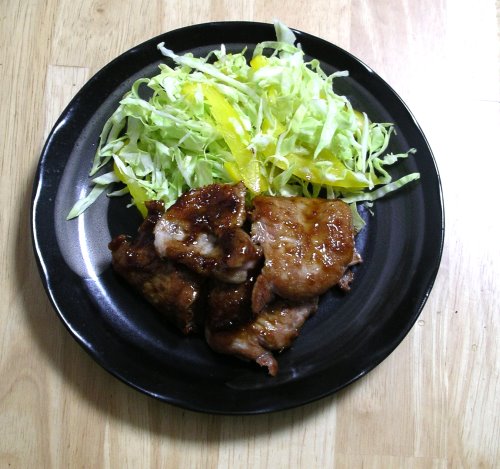 This is shouga-yaki, or ginger-glazed pan-fried pork. It was the first dish Matthew made out of his brand-new Japanese cookbook, and later, the first dish he made for me when I arrived in Kitakami. It's probably our favorite dinner, very quick, easy, and delicious — perfect on a night when we both had to work and still have some bedtime aftershocks to look forward to.
At a famous senbei (cracker/cookie) shop in Esashi, crackers are made by hand — one at a time. You need a reservation a week in advance to buy the popular varieties from this shop. 
The Great Butter Shortage of '08
Saturday, May 17, 2008, 1:19 AM General, FoodPosted by stefanie Rice shortages have been in the news over the last month or so as rice-exporting countries have begun withholding supplies to feed their own people. The shortages don't appear to be affecting Japan, but the country is running low on something important: butter. For the last three weeks or so, finding butter in the stores has been hit or miss, but mostly miss. The stores kindly post signs apologizing for the lack of butter, which is cold comfort when you're contemplating dry toast for breakfast. Japan isn't generally perceived as being a dairy-centric country, so the butter deficit seems kind of surprising. To be sure, there are Japanese dairies and the Japanese do eat things like yogurt, cheese, and, ice cream. But dairy products aren't a staple in the Japanese diet like they are in the American diet, even as bread (and consequently butter) consumption has increased. None of the other dairy products appear to be in low supply (although I did notice a dearth of imported cheese today), either. Just butter. I did find a decent supply of butter in the second store I visited today, but refrained from frantically purchasing all of it.
[ 3 comments ] permalink
I made negitoro don for dinner the other night. Negitoro don is a donburi, meaning a rice bowl. It's made by topping the rice with julienned omelet, chopped raw tuna, sliced green onions, and strips of nori. 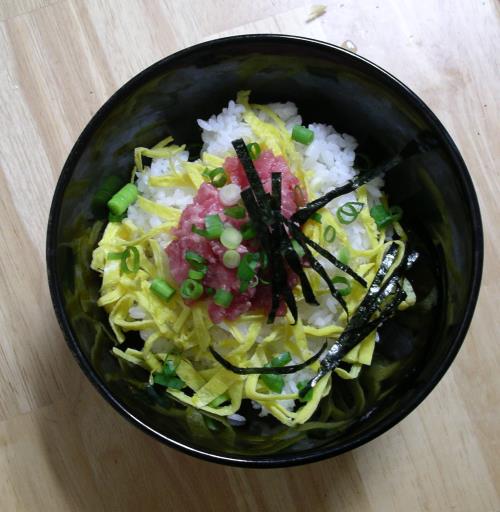 It's not a spring specialty per se, but the colors are very beautiful and springlike.
When Good Pickle Beds Go Bad
Friday, April 18, 2008, 7:07 PM FoodPosted by stefanie Oh, the horror. We've discovered the worst-tasting thing in Japan: pickles from a nuka-zuke bed that's gone off. As we mentioned in the April Fool's Day post, life around Let's Sharing HQ has gotten quite hectic. I haven't had as much time to attend to the house as I did before, so certain things have gotten neglected. Among them was the pickle bed. According to (in my opinion) the best English-language Japanese cookbook, nuka-zuke beds should be turned every day to prevent harmful bacteria from developing. Also, if the bed goes off, you should be able to tell because the bed will smell sour. My pickle bed didn't get turned for a couple of days, but when I got back to it, it smelled like it always had. It did have a thin layer of white funk on top, which I scraped off before turning the bed. I put in some daikon and let them ferment for a day or so, like usual, and they came out shrunken and softer, like usual. Then I tried to serve them. What daikon pickles should taste like: still radishy, but earthy and a little salty. What daikon pickles should not taste like: radishy spoiled milk. *sigh* Five months of cultivation down the drain.
Living in Kitakami places us smack in the middle of sansai ryouri country. As its name translates, sansai ryouri is cooking based on mountain herbs and vegetables. Yesterday, the local model shop owner's wife gave us a bunch of gyojaninniku, a type of mountain garlic or chive, along with instructions for preparing it. It's apparently pretty rare outside of Hokkaido, although the bunch she gave us was from Aomori. We did as she'd instructed, chopping the gyojaninniku finely and steeping it in soy sauce before mixing it with hot rice. We also threw in some minced shiitake (and thank goodness for the easy access to cheap, fresh, delicious shiitake), and Matthew added some nattou.  I don't know whether this technically counts as sansai ryouri, but it was really honking good.
Convenience stores equal convenience food. Hence, grilled-ham-on-a-stick: 
Back Next
|
|















 Calendar
Calendar




